Background
In 1999, the Australian Research Council through its SPIRT scheme funded an Australia-wide dance research project, “Unspoken Knowledges”. The three-year project aimed to study the creation of particular choreographic works and through them to reveal artistic processes and the kinds of creative thought involved in the making of choreographic statements. The project was conducted under the auspices of the Victorian College of the Arts, University of Melbourne in association with industry partners, The Australian Choreographic Centre, the Australian Dance Council (Ausdance) and with cognitive psychologist, Catherine Stevens of the University of Western Sydney.
Three major choreographic works were created during the project and their evolution painstakingly documented via digital camera, logbooks, interviews, discussions and workshop demonstrations. The dynamic interaction between the choreographer and the dancers has produced for the research team a new perspective on choreographic processes and a basis for further research into ways in which audiences receive and respond to dance works. In “Moving Mind” 1 the authors explore the cognitive psychology of contemporary dance-making as manifested in Red Rain, the first major work to emerge from the investigation.
Images in time and space
This paper undertakes a different task; that of an analysis of the second work, Quiescence 2 from the point of view of a dance scholar interested in concepts which relate to all the arts and to those of music and dance in particular. In a second project funded by the Australian Research Council the research team is now engaged with questions about audience reception of finely crafted dance works and the perceptions that lead to responsive engagement.
We are interested in the challenges posed by dance compositions of integrity and subtlety but which do not yield their insights or meanings readily. Genuinely new work often runs the risk of baffling an inexperienced spectator, while program notes which take no responsibility for making the piece accessible run the risk of alienating rather than helping an audience to respond with insight and pleasure. The challenge the present project addresses is to identify possible obscurities and likely points of high communication in the dance-work itself, and thereby to seek ways of facilitating its reception. Communication through images in movement and sound are central to this new investigation.
 The choreographer, Anna Smith, at the Australian Choreographic Centre in Canberra. Each paper square 'notates’ a movement idea in graphics and text.
The choreographer, Anna Smith, at the Australian Choreographic Centre in Canberra. Each paper square 'notates’ a movement idea in graphics and text.For the dance scholar, the human predilection for form and structure pervades both artistic creation and interpretation. A choreographic work can be thought of as a complex of sensuous and expressive movement in an ever changing web of dynamic and spatial relationships. It is through the relationship between the elements that the work begins to exert its power on the human mind.
Skill, knowledge, experience, and ‘artistry’ all contribute to the outcome. Paintings, poems and musical compositions all pose their own problems of formal structure and artists in all fields must meet such challenges if their work is to be successful as aesthetic constructs that communicate something of the artist’s intention or invite an audience to actively construct their own interpretations.
While images unfolding in time are common to all the performing arts it is useful to clarify some distinctions. For example, we have all heard how the other art forms envy the condition of music, the ultimate abstraction. It can also be said that while movement is a basic requirement for the rendition of any art form, dance is the only one in which movement is cultivated for its own sake, as sound is cultivated, or manipulated in music; or clay or stone in the fashioning of a sculpture.
Historically, dance compositions have often been based on narratives that are readily understood as stories. Opera and other dramatic forms share these characteristics and dance as an art form, however abstracted, can never be separated from its embodiment in human forms which carry their own connotations of meaning and significance. But is the ballet Swan Lake only about good and evil or the love of a rather dumb prince for an enchanted swan-maiden? I think not.
A well known critic has remarked that we sense another story being told in the famous Act 2. "By the time the stage is a boil of circling runs and winging arms, we can sense a tension almost poignant—between emptiness and fullness, between wild nature (whether of swans or women dancers) and artistic control", 3 The sudden magic of "these spectral women, who are also powerful and disciplined", is contrasted with the formal conventions of the stage set. The story gains in its power to communicate through elements which are beyond the verbal realm. The perceived distinction between representation and abstraction in dance is not always clear to audiences and notions of abstraction working to add a different level of meaning is not always helpful. These matters are seldom an issue for composers whose perceptions of meaning are often personal and highly subjective.
In a recent interview the Australian composer Peter Sculthorpe spoke movingly of how the relationships between the elements of his music evoked for him the deepest feelings. Pitches, and the relationship beteen them are of particular interest to this artist. "C", he said, "is like the pure white light of God; E, is like eternity". He referred to Mahler’s Song of the Earth and the special significance, the sadness, of the relationship between A and G flat in the structure of the tensions and releases in that work. Mahler, he suggested, seems to be saying that the earth will go on recycling even in the face of individual death. 4
This curious propensity among humans for finding or creating meaning for themselves in artistic constructs like musical compositions, buildings, abstract paintings and dances seems to be unique to our species. Formal structuring plays a significant role in the communication of meaning. 5
It is in the relationships between the parts, the parts and the whole, and the ways in which these are constructed over several time scales that dance shares with music the non-literal ideas that inform compositions in time. Subtle dynamic shadings, tensions and releases, rhythmic patterns and counterpoints are the stuff of which dance phrases, motifs, themes and variations are constructed. The stillness that makes us notice the slow turn of a head is similar to the silent pause that emphasises the delicate musical passage that follows.
These simplicities and complexities seem to carry meaning because our experience tells us that they carry meaning, and often, an intention to communicate. Susanne Langer wrote
…whether a gesture has linguistic meaning or not, it is always spontaneously expressive, too, by virtue of its form: it is free and big, or nervous and tight, quick or liesurely, … 6
Langer called these contrasts "an image of dynamic life." Elite composers or choreographers are masters of just such forms and images. The search for meaning is often resolved when the right form is found.
What can dances communicate?
The several short sequences from the dance work Quiescence (shown on screen) are examples of the concepts discussed. Without music or an explanatory text the movement reveals a range of qualities and images which invites interpretation. Whatever our personal responses it is hard to deny the ‘expressiveness’ of the images.
I suggest that they are mostly in a ‘minor key’; that the repetitions of reaching, falling, slowness, turning away and shutting out, mostly manifested in the upper torso, suggest a palette of feeling tone which is consistent in the sections in which it occurs and reoccurs. In striking contrast is the sequence with the elastic ‘wires’.
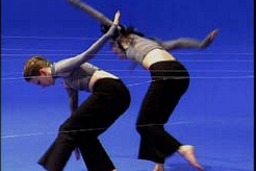 Dancers with wires. In the studio the choreographer explores in movement the idea of the city’s noisy chaos and the encroachment of the city’s technology into the natural world.
Dancers with wires. In the studio the choreographer explores in movement the idea of the city’s noisy chaos and the encroachment of the city’s technology into the natural world.Here the choreographic invention is in passages of extreme busyness, of agitation, hurrying and a certain chaotic urgency. It is noticeable that feet and legs are used with clarity and precision, and often in unison passages. Whatever an individual observer might make of these qualities, it is clear that there is an intention on the part of the artist to communicate something of significance.
And perhaps this is enough for those who like to imagine their own scenarios or simply take pleasure in the skill of the dancers. Others may want to know about the choreographer’s intention. We are told by funding bodies like the Australia Council, and the consultants they employ to advise them, that audiences are hungry for information. 7 At present, it is unclear what kind of information is desired as audiences are often mystified by contemporary art works in any medium. Where does communication fail? Leonard Bernstein’s ground-breaking work in music education 8 suggests that by identifying crucial moments in a composition, and examining individual passages and episodes, audiences are not only enabled to see connections within the work but to grasp the larger ideas behind it, and relate these dynamic forces to their own lives.
The choreographer’s view
Quiescence is a dance work of 35 minutes duration. Selecting a series of ‘steps’ from a coded vocabulary and setting them to music was not a strategy of any interest to the choreographer commissioned to create this work for the “Unspoken Knowledges” project. In collaboration with the dancers the work took her some 350 hours to construct. This included exploration of the basic ideas and images, the invention and testing of all the movement material and the structuring process which brought it all together in its final form.
For the choreographer the impetus for the work grew from her perceptions about the frantic pace and stress of city life compared to the consolations of the natural processes of growth and change experienced in an Australian rain forest. Her reflections on these themes were enriched by her reading of Judith Wright’s poem, Gum Trees Stripping
Say the need’s born within the tree.
and waits a trigger set for light,
say sap is tidal like the sea,
and rises with the soltice heat—
but wisdom shells the words away
to watch this fountain slowed in air
where sun joins earth—to watch the place
at which these silent rituals are.” 9 (Extract)
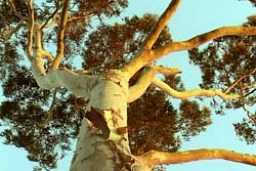 Eucalyptus citriodora. The choreographer used this image in conjunction with Judith Wright’s poem, Gum-trees Stripping. A line from the poem, "this fountain slowed in air where sun joins earth" refers to such an image.
Eucalyptus citriodora. The choreographer used this image in conjunction with Judith Wright’s poem, Gum-trees Stripping. A line from the poem, "this fountain slowed in air where sun joins earth" refers to such an image.Another powerful idea was provided by the image of escape and metamorphosis in Bernini’s sculpture of Daphne and Apollo. The metaphor is ambiguous. Is Daphne escaping the god or is she trapped by her fate? The choreographer chose to use the inspiration of the sculpture to suggest groundedness, connection with the earth and a yearning for release. Is she also suggesting that natural energies are likewise in danger of entrapment?
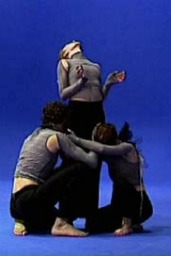 Metamorphosis. Ovid’s tale of Daphne’s metamorphosis into a tree provided a source for the contrasts between movement stilled and bound to the earth, and images of escape and freedom.
Metamorphosis. Ovid’s tale of Daphne’s metamorphosis into a tree provided a source for the contrasts between movement stilled and bound to the earth, and images of escape and freedom.A trip made with the dancers to the deep forest in the Victorian Alps drew on the majesty of the soaring eucalyptus regnans with their dense under-story of mosses and ferns and the shy creatures that live there. The inspiration of this environment with its myriad subtleties of shapes and textures enabled the dancers to sense a connectedness to the natural world and its timeless processes.
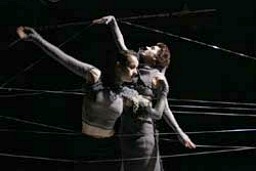 Tangled in time: The mythical woman who suggests the passage of time and the contrasts between that of human life with the growth and decay of the forest giants.
Tangled in time: The mythical woman who suggests the passage of time and the contrasts between that of human life with the growth and decay of the forest giants.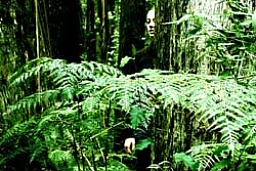 The dancer, Nicole Steven, explores the possibilities for tone and ambience in the contrasts between age and renewal. Photographed in an ancient rain forest near Marysville in the ranges of south eastern Australia.
The dancer, Nicole Steven, explores the possibilities for tone and ambience in the contrasts between age and renewal. Photographed in an ancient rain forest near Marysville in the ranges of south eastern Australia.(The choreographer drew inspiration from the evidence of cycles in time and seasons of decay and rebirth as metaphors for youth and age. Ever-changing patterns of light and shade reveal or veil the forest’s subtle secrets.)
The strident city street and the power lines invading the forest became metaphors for other states of mind. As the work evolved over several months the movement phrases were focussed and edited as the dancers began to refine the shape and mood of the work. In residence at the Australian Choreographic Centre in Canberra the choreographer made notes in her journal; and spoke to the video camera:
I’m thinking about the germination of a tree to the death or falling of the tree. Its history reaches back in time. It will grow in amplitude and magnitude into the future.
Something growing that is rooted and grounded in the earth.
I saw a chunk of huon pine over 2000 years old. It lived when Cleopatra reigned in Egypt.
This tree has witnessed so much. It stores its knowledge and each year it adds to this store.
 Forest roots. One of the many images recorded by the choreographer in her search for new movement material.
Forest roots. One of the many images recorded by the choreographer in her search for new movement material.The forest is organic, complex, but I notice its linear and vertical structures too.
The seasons come and go. The time-line of morning to evening is marked by the bird songs – different songs for each time of day. What sense of time does a tree have - this ‘fountain slowed in air’?
Compared to a tree a butterfly lives its life in milliseconds. Seasons and tides have other cycles.
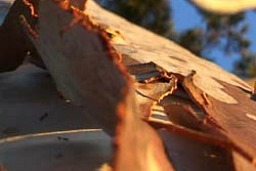 Shedding bark. The old bark splits, revealing the new beneath. It suggested to the choreographer an analogy with shedding skin, a central motif of the work Quiescence.
Shedding bark. The old bark splits, revealing the new beneath. It suggested to the choreographer an analogy with shedding skin, a central motif of the work Quiescence.What is human time in this context.? Youth to old age. Skin, like bark, defines boundaries. Bark is stripped away and grows anew. Human skin and human time run different courses.” And so this work Quiescence, became a meditation on the connection between the real and the imagined and the significance of the metaphors in the experience of the dance artists. Over several months the choreographer and the dancers explored their essential qualities, seeking to find expression in spatial and temporal forms. The embodiment of these ‘silent rituals’ evolved into the work from which the screened images are drawn.
 Bark textures. Contrasts of shape, texture, colour and form suggest analogies in movement.
Bark textures. Contrasts of shape, texture, colour and form suggest analogies in movement.And so this work Quiescence, became a meditation on the connection between the real and the imagined and the significance of the metaphors in the experience of the dance artists. Over several months the choreographer and the dancers explored their essential qualities, seeking to find expression in spatial and temporal forms. The embodiment of these ‘silent rituals’ evolved into the work from which the screened images are drawn.
The dancers’ contribution
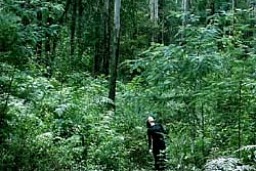 Dancer in forest. The dancer, Deidre Stewart, contemplates the immense scale of the forest. Spatial dimensions and the passage of time in the history of the forest were powerful metaphors for the choreographer’s meditation on the human condition.
Dancer in forest. The dancer, Deidre Stewart, contemplates the immense scale of the forest. Spatial dimensions and the passage of time in the history of the forest were powerful metaphors for the choreographer’s meditation on the human condition.Our case studies have revealed the contributions of the dancers to this process. Successful collaborations can only fully develop under the guidance of a choreographer who values such interaction. Extracts from the choreographer’s journal during the developmental phase reveal this process. “Anna asks Deidre if she is starting to create her own pathway/story through the section that has the response sequence in it.”, and later that day, “Anna asks Deidre to stop as she thinks that Deidre has lost some of the wildness and crispness of the sequence as she is thinking so much about the new material. Deidre is frustrated by the broken rhythm of the phrase.” 10
From each dancer came some aspect of her own unique quality of physicality expressed through the potent combination of imagination and skill; the inextricable connections between mind and body. There was enchantment, absorption, modification, re-creation; and yes, a kind of evolution: a movement subtlety seen in one dancer appeared in the body of another, changed, often extended or transformed by the individual length of an arm or leg, a subtle shift of focus, a sudden stillness, an inclination of the head, perhaps a radical recasting of the rhythmic tensions.
Although improvisation is now a respected and often-used tool for the choreographer, it was not until the digital camcorder allowed the easy capture of improvised material in high quality reproduction that choreographers like Anna Smith could make it a major source of movement ideas and images. For this she needed dancers with highly developed technical and improvisational skills who were willing and eager to engage with her vision and to find in it what was relevant and exciting for them.
My colleague, Robin Grove has suggested that the dancer’s language is a kind of utterance of the body—or the body being uttered by a language it doesn’t entirely know. Verbal language, he says, is full of these unexpected ‘knowledges’, these potentialities and pressures, and it may be that dance-language is the same. 11 Communication here is not directed at an audience; it occurs spontaneously in a small ensemble of dance artists and it’s medium is kinesthetic.
From my observations of several concert soloists I suggest that something similar occurs in the rehearsal and performance of music. It is perhaps, best exemplified in conductors, where gesture and whole body movement are an essential element in what is communicated to both orchestral players and audiences. This should not surprise us. In an historical context the division of music and dance into separate art forms is a relatively recent phenomenon.
The perspective from a dynamical systems view
A developmental psychologist working with young children offers an insight into these complexities.
There is no separation of mind from body because there is no sense in which the mental is abstracted from the material. All is process, all is emergent. Consciousness, imagination, beliefs and desires are coequal with reasoning and language and all are as much a part of human neural activity as is movement or perception. 12
If this is true of a single individual how much more complex is the system which constitutes a small community of dance artists? If we see such a community as both dynamic and evolutionary we also see that the crucial element is time. The process unfolds in time; substantial achievement is the result of the blossoming of ideas, the selective success and further evolution of some of these and the dying away, or editing out of others. Two concepts new to dance but of significance in this framework of thinking are those of self-organization and adaptivity. Self-organisation is defined as "the spontaneous emergence of global coherence out of local interactions". The second of these concepts, adaptivity, is defined as "a system’s capacity to adjust to changes in the environment without endangering its essential organization" 13
We are now able to see that these are useful concepts in the examination of creative processes within groups. What became evident as we examined the processes taking place was something we now recognise as a complex dynamic system, one in which many levels of thought, action and interaction grow or evolve in time. These interactions sometimes resembled those of informal social exchanges as dancers and choreographer discussed the associations and implications of a particular idea or image. At other times the studio was quiet as the dancers worked in solitude to find the sense of ‘rightness’ for a particular feeling state or an intricate pathway already settled in another dancer’s body.
We can trace in the video and other documentation how tentative beginnings become complex explorations and how these influence the imaginations of each dancer. Under the guidance of the choreographer individual dancers transpose images which arise in all the senses into patterns of dance movement—patterns composed of the tensions, releases, stresses and shadings which constitute both physical action and its aural counterpart. The artist’s task is to transform these felt languages into meaningful communication.

